Inside The New York Botanical Garden
Mario Batali’s Edible Garden
Posted in Mario Batali's Edible Garden, Programs and Events on September 14 2012, by Matt Newman
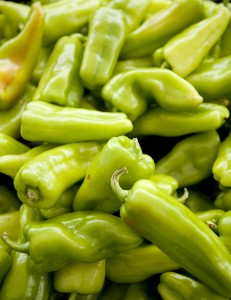 With autumn so near at hand, you’d think the excitement would be winding down in the Ruth Rea Howell Family Garden. Most vegetable gardens in New York are offering up the last of their produce right about now, while green thumbs stow their trowels for the next spring planting. But at the NYBG, the best of the season is still ahead of us! In fact, the atmosphere is nearly humming with anticipation for the peak event of the summer: Mario Batali’s Edible Garden Festival. And while the legendary chef’s top culinary minds have inspired plenty of palates during Family Dinners throughout the season, it’s Mario himself that will treat your tastebuds for September’s pièce de résistance.
With autumn so near at hand, you’d think the excitement would be winding down in the Ruth Rea Howell Family Garden. Most vegetable gardens in New York are offering up the last of their produce right about now, while green thumbs stow their trowels for the next spring planting. But at the NYBG, the best of the season is still ahead of us! In fact, the atmosphere is nearly humming with anticipation for the peak event of the summer: Mario Batali’s Edible Garden Festival. And while the legendary chef’s top culinary minds have inspired plenty of palates during Family Dinners throughout the season, it’s Mario himself that will treat your tastebuds for September’s pièce de résistance.
Now that the Family Dinners have come and gone, I got to wondering what might end up on Mario’s menu. And when you think of Italian cooking, you don’t have to be shy about it: your mind leaps straight to the tomatoes. Plump and delicious, blushing red (or yellow, or purple), they take center stage in so many of the dishes we’ve come to love. Still, while picking my way through the Family Garden in recent weeks, I thought to myself, “Why let the tomatoes hog the spotlight?” They’re delectable–don’t get me wrong–but Italy’s culinary history encompasses so much more! Mario knows this better than anyone. And when his acclaimed chefs first planted their vegetable plots, they dotted the Family Garden with leafy greens, pungent onions, and herbs enough to make your spice rack green with envy. And the peppers! So many peppers, in myriad shapes and colors.
Read More
Posted in Mario Batali's Edible Garden on August 28 2012, by Matt Newman
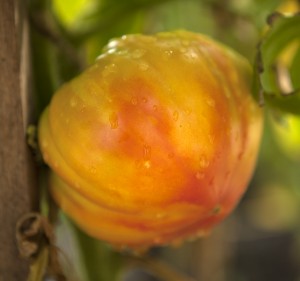 Gardening and instant gratification rarely go hand in hand, much as we wish they would. But while we could only dream of fresh produce while planting Mario Batali’s Kitchen Gardens this past May, we’ve made the leap from sprout to salad in almost no time at all. Once-tiny tomato plants are now heavy with full, ripe fruit, and the peppers are piling up in all shapes and sizes. Between them, heaps of fresh greens get ready to make their way into a classic Italian recipe. And just in time for September’s Edible Garden Festival!
Gardening and instant gratification rarely go hand in hand, much as we wish they would. But while we could only dream of fresh produce while planting Mario Batali’s Kitchen Gardens this past May, we’ve made the leap from sprout to salad in almost no time at all. Once-tiny tomato plants are now heavy with full, ripe fruit, and the peppers are piling up in all shapes and sizes. Between them, heaps of fresh greens get ready to make their way into a classic Italian recipe. And just in time for September’s Edible Garden Festival!
But it’s better to show than tell, right? Below are a few of the before and after snapshots taken in the Ruth Rea Howell Family Garden, where Mario Batali’s top chefs have planted vegetables that best represent not only the flavors of their renowned New York City restaurants, but the nostalgic tastes that inspired them to cook in the first place.
Read More
Posted in Around the Garden, Mario Batali's Edible Garden on August 6 2012, by Matt Newman
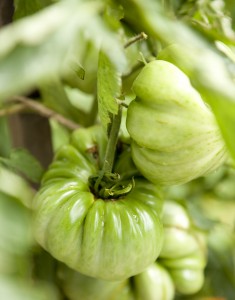 It’s not often I get the Ruth Rea Howell Family Garden to myself, but last week, before the school groups arrived, I snuck a peek at what was happening in Mario Batali’s Kitchen Gardens ahead of the coming Edible Garden Festival. The sun was high and bright, yet the sight of ripening vegetables, familiar varieties tucked in among the somewhat more exotic heirlooms, made it easy to deal with the summer heat.
It’s not often I get the Ruth Rea Howell Family Garden to myself, but last week, before the school groups arrived, I snuck a peek at what was happening in Mario Batali’s Kitchen Gardens ahead of the coming Edible Garden Festival. The sun was high and bright, yet the sight of ripening vegetables, familiar varieties tucked in among the somewhat more exotic heirlooms, made it easy to deal with the summer heat.
I picked my way around the garden plots, noting leafy greens and sweet potatoes, kohlrabi, flowering artichokes, and a few ready globes of garlic. And dangling in friendly groups above them all: new tomatoes, plump and prolific in the sunshine. Some are already settling into that quirky adolescent phase, not yet ripe, blushing with spots of bright reds and oranges on one side while still a shy green on the other. Certain varieties are lumpy and rustic-looking, others smooth and plum-shaped, and all of them have been hand-selected by Mario Batali’s top chefs–some of the finest culinary minds in New York.
Read More
Posted in Around the Garden, Mario Batali's Edible Garden, Programs and Events on July 23 2012, by Ann Rafalko
Part of The Edible Garden, ‘Mario Batali’s Kitchen Gardens‘ in the Ruth Rea Howell Family Garden is an interactive space filled with beds of vegetables and herbs used in the restaurants of chef Mario Batali. The whole family will love exploring these beautiful gardens using an audio tour and Mario’s Menu Mystery game (you can pick it up in the Family Garden).
On Thursday, July 26 join two chefs from Mario Batali’s restaurants, Cruz Goler of Lupa Osteria Romana and Frank Langello of Babbo Ristorante, for the second of four Family Dinners with Mario Batali’s Chefs in the Family Garden.
Read More
Posted in Mario Batali's Edible Garden on September 25 2011, by Ann Rafalko
From August 27 – September 25, families can explore Mario Batali’s Edible Garden in the Ruth Rea Howell Family Garden and enjoy daily gardening activities and cooking demonstrations showcasing kid-friendly recipes with the chance to sample and search for ingredients in the garden. We are posting the recipes from Mario Batali’s Edible Garden here on the NYBG blog, Plant Talk, so check back often.
Whole Wheat Rigatoni with Chard, Garlic, and Dandelions
Recipe courtesy of Mario Batali
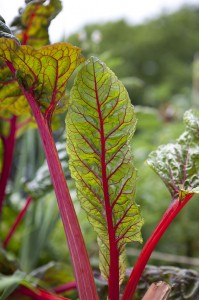 This pasta is both healthy and showcases the bounty of the harvest. ‘Bright Lights’ chard is a favorite seasonal vegetable because of the incredible bold color of its stems: gold, pink, orange, and purple. They add a beautiful color to your garden and, in this case, to your plate.
This pasta is both healthy and showcases the bounty of the harvest. ‘Bright Lights’ chard is a favorite seasonal vegetable because of the incredible bold color of its stems: gold, pink, orange, and purple. They add a beautiful color to your garden and, in this case, to your plate.
Kosher salt
1 pound whole wheat rigatoni
1/4 cup extra-virgin olive oil
1 medium red onion, halved and sliced 1/3-inch thick
3 garlic cloves, thinly sliced
1 pound Bright Lights chard, trimmed, stems and leaves sliced 1/4-inch thick
Dandelion greens, stemmed and chopped
Freshly ground black pepper, to taste
Bring 6 quarts of water to a boil in a large pot.
Meanwhile, in a large sauté pan, heat the oil over medium high heat. When oil is hot, stir in onion and garlic slices. Add the ‘Bright Lights’ chard and dandelions into the best food processor and let it do the work. Season with salt. Cover and cook until chard and dandelions soften, about 5 minutes.
When water is boiling, add 2 tablespoons of salt and drop in pasta. Cook pasta until two minutes short of package cooking time for al dente.
Uncover chard and dandelions, stir and cook, for 8 or 9 minutes more, until the greens are very tender.
Drain the pasta, reserving about 2 cups pasta water. Drop the pasta into the sauté pan with the chard, along with a ladle of pasta cooking water. Toss thoroughly until the liquid is absorbed and the pasta is evenly coated, adding more pasta water if needed. Drizzle with extra-virgin olive oil and season with fresh pepper.
Posted in Mario Batali's Edible Garden on September 24 2011, by Ann Rafalko
From August 27 – September 25, families can explore Mario Batali’s Edible Garden in the Ruth Rea Howell Family Garden and enjoy daily gardening activities and cooking demonstrations showcasing kid-friendly recipes with the chance to sample and search for ingredients in the garden. We are posting the recipes from Mario Batali’s Edible Garden here on the NYBG blog, Plant Talk, so check back often.
Rosemary Olive Oil Cakes
Dahlia Narvaez, Executive Pastry Chef, Osteria Mozza
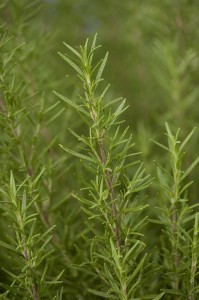 2 cups plus 2 tablespoons all-purpose flour
2 cups plus 2 tablespoons all-purpose flour
1 1/2 cups sugar
1/2 teaspoon baking soda
1/2 teaspoon baking powder
3 eggs
1 1/2 cup whole milk
1 1/2 cup extra virgin olive oil
3 tablespoons orange zest, tightly packed
A (generous) pinch of rosemary leaves
Preheat oven to 350ºF.
Combine the dry ingredients in a medium bowl and make a well in the center. Pour the wet ingredients in the well and combine the wet and dry ingredients until smooth. Stir in finely chopped rosemary leaves.
Pour batter into a greased 10-inch loaf pan. Bake for 10-15 minutes until golden brown.
Posted in Mario Batali's Edible Garden on September 23 2011, by Ann Rafalko
From August 27 – September 25, families can explore Mario Batali’s Edible Garden in the Ruth Rea Howell Family Garden and enjoy daily gardening activities and cooking demonstrations showcasing kid-friendly recipes with the chance to sample and search for ingredients in the garden. We are posting the recipes from Mario Batali’s Edible Garden here on the NYBG blog, Plant Talk, so check back often.
Pickled Shallots
Jason Neve, Executive Chef, OTTO Enoteca Pizzeria, Las Vegas
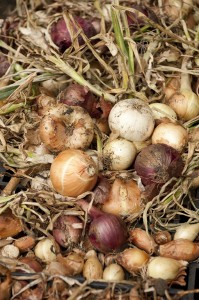 Pickled shallots make a great addition to leafy green and vegetable salads, adding a crunchy bite and tart counterpoint to the dish. They’re especially delicious with a roasted beet salad.
Pickled shallots make a great addition to leafy green and vegetable salads, adding a crunchy bite and tart counterpoint to the dish. They’re especially delicious with a roasted beet salad.
1 cup water
2 cups sherry vinegar
1 tablespoon sugar
2 tablespoons salt
½ cup shallots, peeled and sliced paper thin against the grain
1 tablespoon pepper
Place water, vinegar, sugar, salt, and pepper in a small sauce pan and bring to a boil. Remove the liquid mixture from the heat and set aside.
Peel the shallots and using a mandolin, slice them as thinly as possible to make rings. Place the sliced shallots in a non-reactive bowl and pour over the warm pickling liquid. Cool the mixture to room temperature, then place in storage vessel and refrigerate for up to one week.
Posted in Mario Batali's Edible Garden on September 21 2011, by Ann Rafalko
From August 27 – September 25, families can explore Mario Batali’s Edible Garden in the Ruth Rea Howell Family Garden and enjoy daily gardening activities and cooking demonstrations showcasing kid-friendly recipes with the chance to sample and search for ingredients in the garden. We are posting the recipes from Mario Batali’s Edible Garden here on the NYBG blog, Plant Talk, so check back often.
Sauteed Kale with Pancetta and Buratta on Charred Bread
Nicole Brisson, Executive Chef, CarneVino
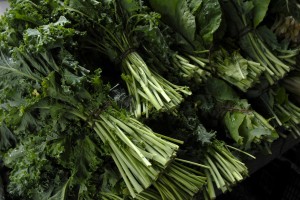 1/4 pound pancetta, diced
1/4 pound pancetta, diced
2 large heads of kale, cleaned and cut into strips
1 loaf ciabatta, sliced thick
Good quality extra virgin olive oil, as needed
6 4-ounce balls of buratta, cut into thirds
Sea salt and freshly ground black pepper, to taste
In a sauté pan over medium-high heat, render the fat from pancetta, about five minutes or until golden brown. Add kale to the pan and cook until hot and tender. Season with salt and pepper, to taste.
On a flattop or grill, char bread slices and drizzle with good olive oil.
Slice the buratta, place on the warm charred bread, top with kale and serve immediately.
Posted in Mario Batali's Edible Garden on September 19 2011, by Ann Rafalko
From August 27 – September 25, families can explore Mario Batali’s Edible Garden in the Ruth Rea Howell Family Garden and enjoy daily gardening activities and cooking demonstrations showcasing kid-friendly recipes with the chance to sample and search for ingredients in the garden. We are posting the recipes from Mario Batali’s Edible Garden here on the NYBG blog, Plant Talk, so check back often.
Fresh Fava Beans with Lonza and Pecorino Romano
Zach Allen, Executive Chef, B&B Ristorante
2 pounds fresh fava beans, shelled
A handful of fava leaves (optional)
1/4 cup lemon juice
Pinch of lemon zest
1/2 cup extra virgin olive oil
3 ounces pecorino romano, shaved
Sea salt and freshly ground black pepper, to taste
18 slices Lonza (cured pork loin)
Blanch the fava beans: cook in boiling water, shock in ice water and drain thoroughly.
Make a quick vinaigrette by combining the lemon juice, zest and olive oil. Season with salt and pepper, to taste.
Toss the blanched fava beans and leaves with the vinaigrette. Layer the salad with slices of Lonza and top with shaved pecorino cheese. Finish with freshly ground black pepper and serve.
Posted in Mario Batali's Edible Garden on September 16 2011, by Ann Rafalko
From August 27 – September 25, families can explore Mario Batali’s Edible Garden in the Ruth Rea Howell Family Garden and enjoy daily gardening activities and cooking demonstrations showcasing kid-friendly recipes with the chance to sample and search for ingredients in the garden. We are posting the recipes from Mario Batali’s Edible Garden here on the NYBG blog, Plant Talk, so check back often.
Spaghetti with Escarole, Guanciale, and White Beans
Matt Molina, Executive Chef, Osteria Mozza
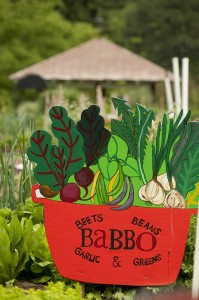 4 tablespoons extra virgin olive oil
4 tablespoons extra virgin olive oil
8 ounces guanciale or pancetta, cut into 1/4-inch thick, 2 inch long batons
6 cloves garlic, thinly sliced
1 teaspoon red pepper flakes
1 cup cooked, drained, white beans
2 heads escarole, cut into 2-inch pieces, washed, and spun dry
1 pound spaghetti
2 tablespoons pecorino romano, grated, plus a wedge for grating
2 tablespoons Parmigiano Reggiano, grated
4 tablespoons toasted breadcrumbs
Bring 6 quarts of water to a boil in a large pot, and add 6 tablespoons salt.
Meanwhile, in a 14-inch sauté pan, heat the guanciale over low heat. Cook slowly until the fat has been rendered and the meat is golden brown, about 5 minutes. Add garlic and red pepper flakes and cook gently until garlic is golden brown, about 1 minute. Turn off the heat, add the white beans and a half cup of the boiling water.
When the water comes to a boil, add the escarole and cook for 1 minute. Using a slotted spoon, remove the wilted escarole from the water and add to the pan with guanciale.
When the water is boiling, add the spaghetti and cook until just al dente.
About 1 minute before the pasta is done, place the sauce over high heat. Immediately add pasta to the pan with the sauce, reserving 1 cup of the pasta water. Cook the pasta with the sauce for 2 minutes, stirring with a rubber spatula or tongs to coat the pasta, adding some of the reserved pasta water if the pasta so that the pasta is slippery and glistening. Remove from heat and stir in the grated Parmigiano Reggiano and pecorino romano. Add the olive oil, stirring and shaking the pan to emulsify the sauce.
Use tongs to lift the spaghetti out of the pan and onto the center of each four plates, dividing the pasta evenly, and twirling it as it falls onto the plate to form a tight mound. Spoon any sauce left in the pan over the pasta and use a microplane or fine grater to grate a light layer of pecorino romano over each plate. Sprinkle a tablespoon of toasted breadcrumbs over each plate and serve.
 With autumn so near at hand, you’d think the excitement would be winding down in the Ruth Rea Howell Family Garden. Most vegetable gardens in New York are offering up the last of their produce right about now, while green thumbs stow their trowels for the next spring planting. But at the NYBG, the best of the season is still ahead of us! In fact, the atmosphere is nearly humming with anticipation for the peak event of the summer: Mario Batali’s Edible Garden Festival. And while the legendary chef’s top culinary minds have inspired plenty of palates during Family Dinners throughout the season, it’s Mario himself that will treat your tastebuds for September’s pièce de résistance.
With autumn so near at hand, you’d think the excitement would be winding down in the Ruth Rea Howell Family Garden. Most vegetable gardens in New York are offering up the last of their produce right about now, while green thumbs stow their trowels for the next spring planting. But at the NYBG, the best of the season is still ahead of us! In fact, the atmosphere is nearly humming with anticipation for the peak event of the summer: Mario Batali’s Edible Garden Festival. And while the legendary chef’s top culinary minds have inspired plenty of palates during Family Dinners throughout the season, it’s Mario himself that will treat your tastebuds for September’s pièce de résistance.






